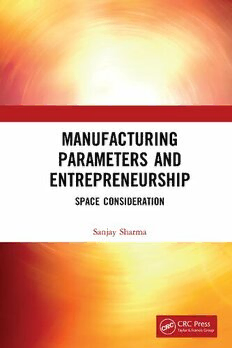
Manufacturing Parameters and Entrepreneurship: Space Consideration PDF
Preview Manufacturing Parameters and Entrepreneurship: Space Consideration
Manufacturing Parameters and Entrepreneurship Manufacturing Parameters and Entrepreneurship Space Consideration Sanjay Sharma First edition published 2021 by CRC Press 6000 Broken Sound Parkway NW, Suite 300, Boca Raton, FL 33487-2742 and by CRC Press 2 Park Square, Milton Park, Abingdon, Oxon, OX14 4RN © 2021 Taylor & Francis Group, LLC CRC Press is an imprint of Taylor & Francis Group, LLC Reasonable efforts have been made to publish reliable data and information, but the author and pub- lisher cannot assume responsibility for the validity of all materials or the consequences of their use. The authors and publishers have attempted to trace the copyright holders of all material reproduced in this publication and apologize to copyright holders if permission to publish in this form has not been obtained. If any copyright material has not been acknowledged please write and let us know so we may rectify in any future reprint. Except as permitted under U.S. Copyright Law, no part of this book may be reprinted, reproduced, transmitted, or utilized in any form by any electronic, mechanical, or other means, now known or here- after invented, including photocopying, microflming, and recording, or in any information storage or retrieval system, without written permission from the publishers. For permission to photocopy or use material electronically from this work, access www.copyright.com or contact the Copyright Clearance Center, Inc. (CCC), 222 Rosewood Drive, Danvers, MA 01923, 978- 750-8400. For works that are not available on CCC please contact [email protected] Trademark notice: Product or corporate names may be trademarks or registered trademarks, and are used only for identifcation and explanation without intent to infringe. ISBN: 9780367558543 (hbk) ISBN: 9781003107163 (ebk) Typeset in Times LT Std and Optima LT Std by KnowledgeWorks Global Ltd. Contents Preface......................................................................................................................vii About the Author ......................................................................................................ix Chapter 1 Introduction ..........................................................................................1 1.1 Manufacturing Space.................................................................2 1.1.1 Raw Material/Input Material .......................................3 1.1.2 Work-in-Process Inventory ...........................................3 1.1.3 Final Product/Assembly ...............................................4 1.2 Manufacturing Quality ..............................................................6 1.2.1 Quality Consideration ..................................................6 1.2.2 Outcomes Concerning Quality .....................................7 1.2.3 Occupied Space .......................................................... 11 1.3 Production Backorders ............................................................12 1.3.1 Suitable Approach ......................................................12 1.3.2 Specifc Inclusion ....................................................... 13 Chapter 2 Space Consideration ...........................................................................15 2.1 Conceptualization .................................................................... 15 2.1.1 Assumptions ...............................................................15 2.1.2 Intermediate Space ..................................................... 17 2.2 Formulation ............................................................................. 17 2.2.1 Manufacturing Cycle .................................................. 18 2.2.2 Representation for Temporary Storage. ...................... 21 2.3 Analysis ...................................................................................23 Chapter 3 Quality Aspects ..................................................................................43 3.1 Basic Understanding ................................................................ 43 3.1.1 Manufacturing Cycle with Quality Criterion .............44 3.2 Mathematical Treatment ..........................................................45 3.2.1 Variation of Maximum Production-Inventory Level ........................................................................... 47 3.2.2 Percentage Reduction in Maximum Inventory Level ...........................................................................48 3.2.3 Percentage Increase in Maximum Inventory Level ...........................................................................49 3.3 Examples and Generalization .................................................. 51 v vi Contents Chapter 4 Backorders ..........................................................................................83 4.1 Maximum Inventory Level ......................................................83 4.1.1 Increase in Maximum Inventory Level ......................89 4.1.2 Reduction in Maximum Inventory Level ...................90 4.2 Entrepreneurial Application ....................................................97 4.3 Quality Inclusion ................................................................... 118 4.3.1 Quality Inclusion along with Backorders ................. 118 4.3.2 Total Related Cost ....................................................120 4.3.3 Variation of Inventory with Respect to the Quality Level ............................................................ 122 Chapter 5 Conclusion ........................................................................................ 133 5.1 Useful Results ........................................................................ 133 5.1.1 In the Context of Space Consideration ..................... 133 5.2 Innovation Efforts .................................................................. 135 5.2.1 Manufacture of Innovative Item along with Regular Product................................................ 136 5.2.2 Handling Innovative Item Independently ................. 143 5.3 Future Scope .......................................................................... 147 Advanced Reading I ............................................................................................. 153 Advanced Reading II ........................................................................................... 163 Index ...................................................................................................................... 179 Preface Entrepreneurship has many facets including commercial and technical aspects, among others. Manufacturing entrepreneurship may specifcally relate to the produc- tion or manufacturing of items. After conceptualizing a product or an item, suitable space is needed for an arrangement of facilities and storage. While manufacturing at the available space, quality aspects need to be considered along with the produc- tion backorders. This book is concerned with manufacturing entrepreneurship while taking into consideration various factors/parameters and space requirement. Success in the context of manufacturing entrepreneurship lies in knowing the operational factors and their challenge in the real world. The concepts generated are useful for the new production setup as well as for a running organization. After the start of a company, manufacturing entrepreneurship has to deal with uncertainties in which an operational factor or manufacturing parameter can change. Under such a sce- nario, a suitable response is necessary to obtain the overall benefcial manufacturing environment or to make it feasible. This is also helpful in facilitating the change/ disturbance or minimizing its ill effects. The present book is especially concerned with manufacturing entrepreneurship in the context of space consideration. Dr. Sanjay Sharma National Institute of Industrial Engineering vii About the Author Dr. Sanjay Sharma is Professor at National Institute of Industrial Engineering (NITIE), Mumbai, India. He is an operations and supply chain management educator and researcher. He has more than three decades of experience in industrial, manage- rial, teaching/training, consultancy, and research; he also has many awards/honors to his credit. He has published six books and papers in various journals such as The European Journal of Operational Research, International Journal of Production Economics, Computers & Operations Research, International Journal of Advanced Manufacturing Technology, Journal of the Operational Research Society, and Computers and Industrial Engineering. Sharma is also a reviewer for several inter- national journals, and is also on the editorial board of a few journals, including the International Journal of Logistics Management (an ‘A’ rating Emerald Journal). ix
